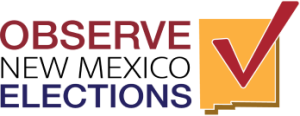ONME releases executive summary of findings from this fall’s municipal elections
Santa Fe, NM – Today, Observe New Mexico Elections (ONME) released its Executive Summary of findings gathered by 111 election observers across 106 polling sites in 11 New Mexico municipalities. Observers found that election processes went smoothly and were well-administered, polls opened and closed on time, and voters were able to cast their ballots securely and without disruption.
ONME spearheaded poll observation efforts during New Mexico’s 2025 municipal elections, observing the preparation and conduct of key local electoral processes as well as the certification of results. Trained observers monitored poll worker training, logic and accuracy testing (where voting machines are tested to confirm they are counting accurately), absentee ballot processing, early voting, and Election Day voting.
Election observers were assigned to the following 11 municipalities: Alamogordo (Otero County), Albuquerque (Bernalillo County), Carlsbad (Eddy County), Clayton (Union County), Farmington (San Juan County), Gallup (McKinley County), Las Cruces (Doña Ana County), Las Vegas (San Miguel County), Santa Fe (Santa Fe County), Silver City (Grant County), and Taos (Taos County).
“Our preliminary findings in this report reflect widespread positive findings, reinforcing that our state is indeed a leader in overall election performance,” said Carmen López, Co-Lead of ONME. “In general, polls opened and closed on time and experienced minimal disruptions to voting in the locations we observed. Of course, there are always areas for improvement. Observers noted that counties generally did not train poll workers on how to meet federal and state requirements related to translation and interpretation services, posting clearer signage, and providing required accommodations for people with disabilities. That’s why this effort is so important – nonpartisan observation helps show what’s working well and where election processes can be improved and made more consistent and accessible.”
- Logic and Accuracy Testing: Testing was calm, organized, and transparent in most locations. Election staff carefully followed established procedures, tested multiple types of equipment, and resolved issues as they arose. Public access and site accessibility varied, and improvements can be made in the future regarding clear signage and navigation for people with disabilities.
- Poll Worker Training: Trainings across the state were professional, organized, and welcoming. Many counties showed improvement from 2024, especially regarding accessibility of training venues. Some counties also expanded their coverage of technical topics, such as operating electronic pollbooks and troubleshooting tabulators. While the overall quality of training was strong, one area of improvement is to maintain uniform training across counties (even where most participants are familiar with the process), and cover topics in more detail – such as accessibility and language-related voter accommodations.
- Absentee Ballot Processing: ONME observers monitored absentee ballot processing in Albuquerque, Santa Fe, and Las Cruces, finding that processes were well-organized, transparent, and secure in all three locations. Physical accessibility varied by location, particularly in Las Cruces, where officials are currently in the process of relocating to a more accessible site in the future.
- Early In-person Voting: From October 17 to November 1, 2025, early voting ran smoothly and on schedule, and poll workers were prepared and professional. Same-day registration worked efficiently, and equipment issues were isolated and quickly resolved by on-site technicians. One area of improvement would be to have consistency in how information and instructions are displayed, as well as ensuring adequate language translations.
- Election Day Voting: Election Day processes were generally efficient, transparent, and well-administered. Nearly every site opened and closed on time, with only a few minor delays caused by building access issues or long lines. Ballot reconciliation at the end of each day was careful and transparent, and instances of electioneering and campaign activity near polling places were handled appropriately. A few issues observers noted at select sites included a lack of clear signage, inadequate language accessibility, and navigation challenges for voters with mobility needs.
“We are proud to report secure, transparent, and well-administered elections this fall. ONME’s timely and comprehensive public reporting wouldn’t be possible without the hard work and dedication of our election observers and volunteers who put in the time and training to help us carry out this effort,” said Barbara Vigil, ONME Board Member and former New Mexico Supreme Court Justice. “Between last year’s general election and this year’s municipal elections, ONME is showing it’s possible to engage citizens in a widespread effort to monitor the integrity and accessibility of elections in their state. In fact, we’re getting interest from other states that want to replicate our system. We are excited to see how this movement continues and look forward to our next big effort, which will be observing the election process in every county in New Mexico for next year’s midterm elections.”
To view ONME’s Executive Summary of preliminary findings, click here.
ONME will release a full, comprehensive report with more detailed analysis in mid-January.
About Observe New Mexico Elections (ONME)
The mission of Observe New Mexico Elections is to increase transparency and trust in New Mexico’s elections by training and mobilizing nonpartisan election observers throughout the state. Observers report on election laws and procedures, without interfering in the electoral process. Findings from their observations will be compiled to assess the overall quality of elections in New Mexico.
###
